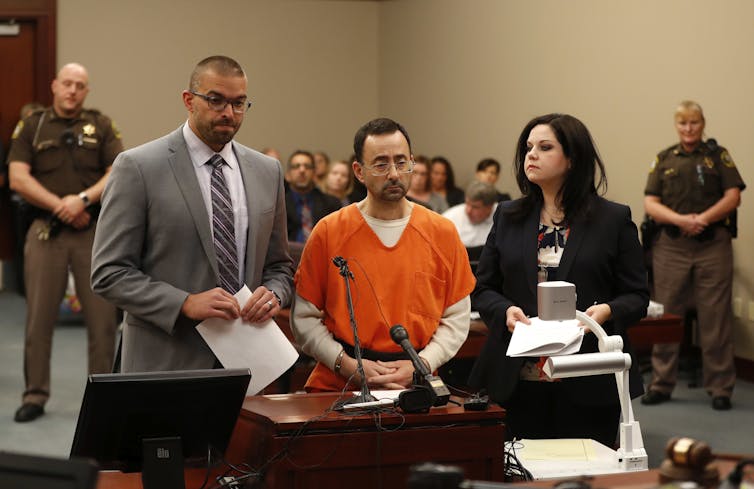Mr. Smith was a 27-year-old man referred for psychological treatment after sexually offending against a 13-year-old boy. He initially denied the charge, but eventually admitted to sexually abusing multiple youth. He later admitted he’d been attracted to boys since his own adolescence.
Mr. Smith is actually a case composite from my first book on pedophilia. But the description is representative of stories I’ve heard from the hundreds of individuals I’ve talked with as a psychologist and researcher over the past 25 years.
Most men are sexually attracted to sexually mature young adults. But a small minority of men are sexually attracted to other age groups, from infants to the elderly. These age-based attractions are called chronophilias.
My research focuses on chronophilias and sexual offending against children. Recently, I’ve started to think about these age-specific attractions as sexual orientations for age, similar to how we understand sexual orientation for gender. This is quite different from the traditional way that psychologists view chronophilias, as sexual preferences that are distinct from someone’s identity.
This idea – that chronophilias can be understood as sexual orientations for age – is provocative, because it raises ethical, legal and scientific questions about how we think about sexual orientation, the etiology of sexual preferences and how we respond to sexual offenses against minors.
Attraction to an atypical age group
The best-known atypical chronophilia is pedophilia, referring to sexual attraction to prepubescent children (no physical changes due to puberty). Pedophilia has received the most attention because it helps explain many cases of child pornography use and child sexual abuse.
Hebephilia (some physical puberty changes, but still obviously immature) is becoming better known to researchers and the public. Though ultimately rejected, the American Psychiatric Association considered including hebephilia in the latest version of its diagnostic manual (DSM-5), where it would have joined pedophilia as a recognized mental disorder.

There are other lesser-known chronophilias, including attraction to infants or toddlers (nepiophilia) and sexually maturing teens who are not yet adults (ephebophilia). Ephebophilia can explain some cases of statutory rape involving “consensual” relationships between adults and teens who are under the legal age of consent. Surprisingly little research is available about these crimes, even though they are frequent, with approximately one in four rapes recorded by police in the U.S. involving statutory cases.
Other atypical chronophilias focus on middle-aged persons (mesophilia) or the elderly (gerontophilia). There is almost no research on mesophilia or gerontophilia, probably because acting on them is legal, as long as the other person consents.
The typical attraction to young sexually mature adults is called teleiophilia. Being drawn to this age category makes biological and evolutionary sense. Acting on this age attraction is most likely to lead to reproductive success (having children). Being attracted to someone who is prepubertal, pubertal or post-menopausal would not lead to offspring. Scientists would expect the traits underlying these attractions to be less likely to appear in future generations since they wouldn’t be passed on.
Where do chronophilias come from?
Like sexual orientation for gender, pedophilia (and perhaps other chronophilias as well) is often experienced as something that someone discovers about themselves as he grows up. Like their peers, these young males become attracted to children their own age or younger – imagine a 12-year-old developing his first crush on an 11-year-old girl at his school. Unlike their peers, whose age interests shift as they grow older, males with pedophilia continue to be sexually attracted to young children. Picture the same boy, now 17, who is still attracted to his kid sister’s friends instead of his high school peers.

I think chronophilias are the result of errors in age detection, where heterosexual male preferences for youth cues like big eyes and smooth skin are not offset by sexual maturity cues like full breasts and curvy hips. For pedophilia, hebephilia and ephebophilia, the youthfulness cues dominate; for mesophilia and gerontophilia, the preference for youth cues is actually reversed.
I refer only to men here because that’s whom almost all the research on chronophilias has focused on. And men are much more likely to show variations in their sexual age interests than women. For example, one study found men were more than twice as likely as women to report ever having sexual fantasies about a child under age 12.
It’s not clear why or how age detection gets scrambled. There is growing evidence that pedophilic men are more likely to show prenatal and early childhood signs such as neurodevelopmental problems, have experienced head injuries and be lower in IQ. Researchers have also found that pedophilic men have differences in their brains’ white matter in areas that are involved in networks that help process sexual stimuli.
Even less is known about other atypical chronophilias. Developmental studies are rare because scientists (and parents) are reluctant to include children and adolescents in sex research. Instead, we rely on studies asking adults to remember their earlier lives or looking at developmental markers with adults.
There are many other important questions that remain to be addressed. When do chronophilias emerge and how stable are they over a person’s lifetime? What are the female experiences of chronophilias? What might be effective treatments to prevent acting on sexual interests in children and underage adolescents?
We don’t really know how many people have chronophilias. But given my estimate that up to 1 percent of men have pedophilia, it’s vital for researchers to understand the causes of chronophilias and how best to respond to cases involving young people or nonconsent.
AUTHOR: Michael Seto: Forensic Research Director at the Royal Ottawa Health Care Group and Associate Professor of Psychiatry, University of Toronto
CREDIT LINK: https://theconversation.com/what-are-chronophilias-88074<img src="https://counter.theconversation.com/content/88074/count.gif?distributor=republish-lightbox-advanced" alt="The Conversation" width="1" height="1" />

